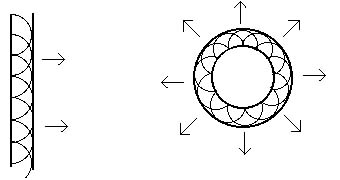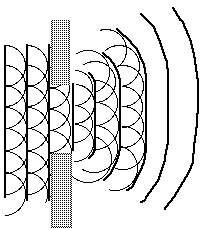20.1 Huygens' Principle

christian Huygens, a Dutch Physicist and contemporary of Sir Isaac
Newton, formulated a principle or way of explaining the propagation
of light waves that is still very useful today. Huygens' Principle
is that the future location of a wave is determined by considering
each point on the present wave as a source for new wavelets. The
new, future wave is the envelope of these wavelets.
The envelope of these wavelets is a line drawn across them to
contain them and it accurately locates the future wave. This idea
is best understood by the illustrations in Figure 20.1. There
a plane wave moves to the right and a circular wave expands from
its origin.

Figure 20.1 Each point on a wave may be treated
as a source for new "wavelets". The new position of
the wave is the envelope of these little wavelets. This is Huygen's
Principle.
In Figure 20.1 the illustrations are symmetric and Huygens' Principle
simply confirms what we would expect. But Figure 20.2 shows a
plane wave passing through a hole in a barrier. There a barrier
blocks parts of the wave and the symmetry is broken. Some of the
wavelets are stopped. The envelope of the remaining wavelets spreads
around the edges of the hole; the wave bends past the edges of
the hole. This behavior is known as diffraction and is characteristic
of waves-of all waves. As the hole becomes smaller this bending
or diffraction becomes greater.

Figure 20.2 Plane waves encounter a barrier with
an opening. All of the wavelets necessary to create a new plane
wave are not present. The resulting wave bends into the region
that appears to be blocked.





